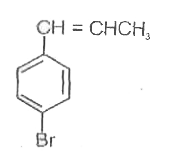The reaction of C6H5CH=CHCH3 with HBr produces :

C6H5C∣BrHCH2CH3
C6H5CH2C∣BrHCH3
C6H5CH2CH2CH2Br
The correct Answer is:2
To solve the problem of the reaction of C6H5CH=CHCH3 with HBr, we will follow these steps:
Step 1: Identify the Structure
The compound C6H5CH=CHCH3 can be broken down as follows:
- C6H5 represents a phenyl group (benzene ring).
- CH=CH represents a double bond between two carbon atoms.
- CH3 represents a methyl group.
So the full structure can be visualized as:
C6H5|C||C|CH3
Step 2: Apply Markovnikov's Rule
When HBr reacts with an alkene, Markovnikov's rule states that the hydrogen atom (H) will attach to the carbon atom that has more hydrogen atoms already attached. In this case, we have two possible sites for the HBr to add across the double bond.
Step 3: Determine Possible Carbocation Intermediates
1. First Possible Carbocation (Intermediate A):
- If H adds to the carbon of the double bond that is part of the phenyl group (C6H5), the structure will be:
C6H5|CH|CH3
This leads to a carbocation at the other carbon (CH) which is less stable.
2. Second Possible Carbocation (Intermediate B):
- If H adds to the other carbon (the one attached to CH3), the structure will be:
C6H5|CH2+|CH3
This carbocation is more stable due to resonance stabilization from the phenyl group.
Step 4: Nucleophilic Attack by Bromide Ion
Once the more stable carbocation (Intermediate B) is formed, the bromide ion (Br-) will attack the positively charged carbon:
- The Br will attach to the carbon that has the positive charge, leading to the final product.
Step 5: Write the Final Product
The final product can be represented as:
C6H5|CH|CH2Br
In condensed form, this is C6H5CH(CH2Br)CH3.
Conclusion
The reaction of C6H5CH=CHCH3 with HBr produces C6H5CH(CH2Br)CH3.
The compound C6H5CH=CHCH3 can be broken down as follows:
- C6H5 represents a phenyl group (benzene ring).
- CH=CH represents a double bond between two carbon atoms.
- CH3 represents a methyl group.
C6H5|C||C|CH3
When HBr reacts with an alkene, Markovnikov's rule states that the hydrogen atom (H) will attach to the carbon atom that has more hydrogen atoms already attached. In this case, we have two possible sites for the HBr to add across the double bond.
1. First Possible Carbocation (Intermediate A):
- If H adds to the carbon of the double bond that is part of the phenyl group (C6H5), the structure will be:
C6H5|CH|CH3
This leads to a carbocation at the other carbon (CH) which is less stable.
- If H adds to the other carbon (the one attached to CH3), the structure will be:
C6H5|CH2+|CH3
This carbocation is more stable due to resonance stabilization from the phenyl group.
Once the more stable carbocation (Intermediate B) is formed, the bromide ion (Br-) will attack the positively charged carbon:
- The Br will attach to the carbon that has the positive charge, leading to the final product.
The final product can be represented as:
C6H5|CH|CH2Br
In condensed form, this is C6H5CH(CH2Br)CH3.
The reaction of C6H5CH=CHCH3 with HBr produces C6H5CH(CH2Br)CH3.
Topper's Solved these Questions
- HYDROCARBONSBOOK - AAKASH INSTITUTE ENGLISHCHAPTER - HYDROCARBONSEXERCISE - Assignment(Section - B) (Obejctive type question)
5 Videos
- HALOALKANES AND HALOARENES BOOK - AAKASH INSTITUTE ENGLISHCHAPTER - HALOALKANES AND HALOARENES EXERCISE - ASSIGNMENT SECTION -D
15 Videos
- HYDROGENBOOK - AAKASH INSTITUTE ENGLISHCHAPTER - HYDROGENEXERCISE - ASSIGNMENT (SECTION - D) (Assertion-Reason Type question)
15 Videos
Similar Questions
Knowledge Check
The reaction of C6H5CH=CHCHO with NaBH4 give:
AC6H5CH2CH2CH2OHBC6H5CH=CHCH2OHCC6H5CH2CH2CHODC6H5CH2CHOHCH3The reaction of C6H5CH=CHCHO with LiAlH4 gives :
AC6H5CH2CH2CH2OHBC6H5CH=CHCH2OHCC6H5CH2CH2CHODC6H5CH2CHOHCH3
In the given reaction CH3CH2CH=CHCH3X−−→CH3CH2COOH+
CH3COOH
The X is
View SolutionA chemist plans to prepare 1- bromo-2- pentene by the following reaction
CH3CH2CH=CHCH3+NBSΔ−−→CH3CH2CH=CHCH2Br
This plane is not likely to work because
View SolutionWhat are the major products formed in the following reactions ?
(i) C6H5−CH2−CH=CH2+HBr→
(ii)
View SolutionProduct the major product in the following reactions:
i. C6H6+(CH3)2CHCH2OHH2SO4−−−→...
ii. C6H5C2H5(i)Br2heat light−−−−−−−−−−−→(ii)NaCN....
View SolutionIdentify the major product in the following reactions :
(i)
(ii) C6H5COOH+CH3MgI→?+?.
View SolutionPredict the major product in the following reaction :
C6H5−CH2CO2CH3(i)CH3MgBr(Excess)−−−−−−−−−−−−−−→(ii)H⊕.
View Solution
